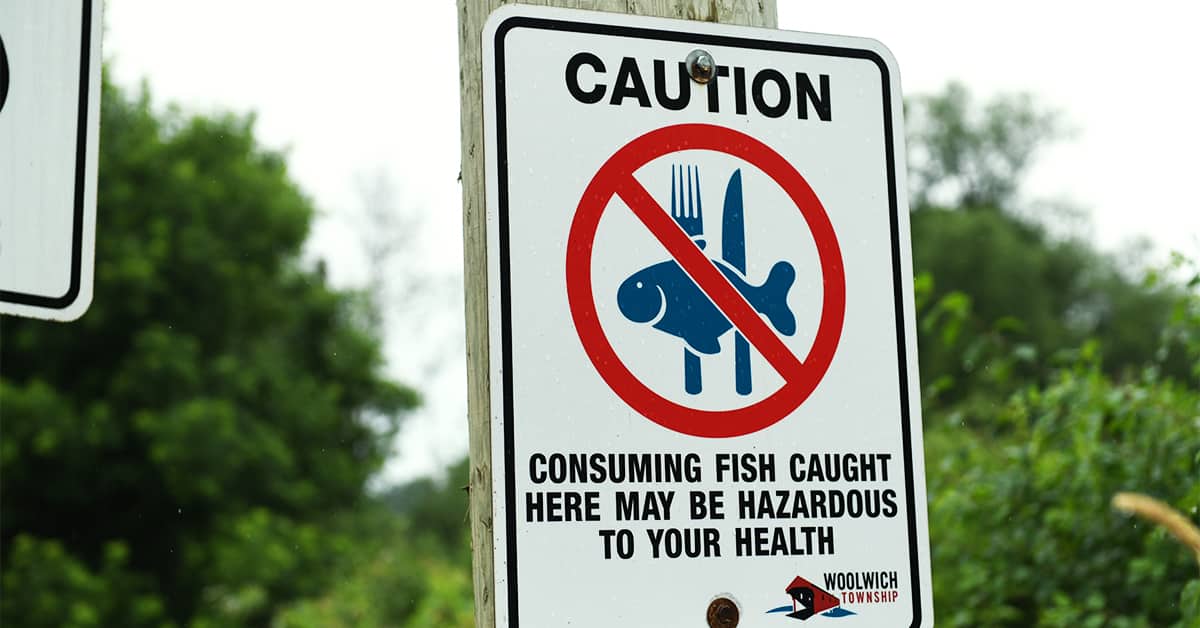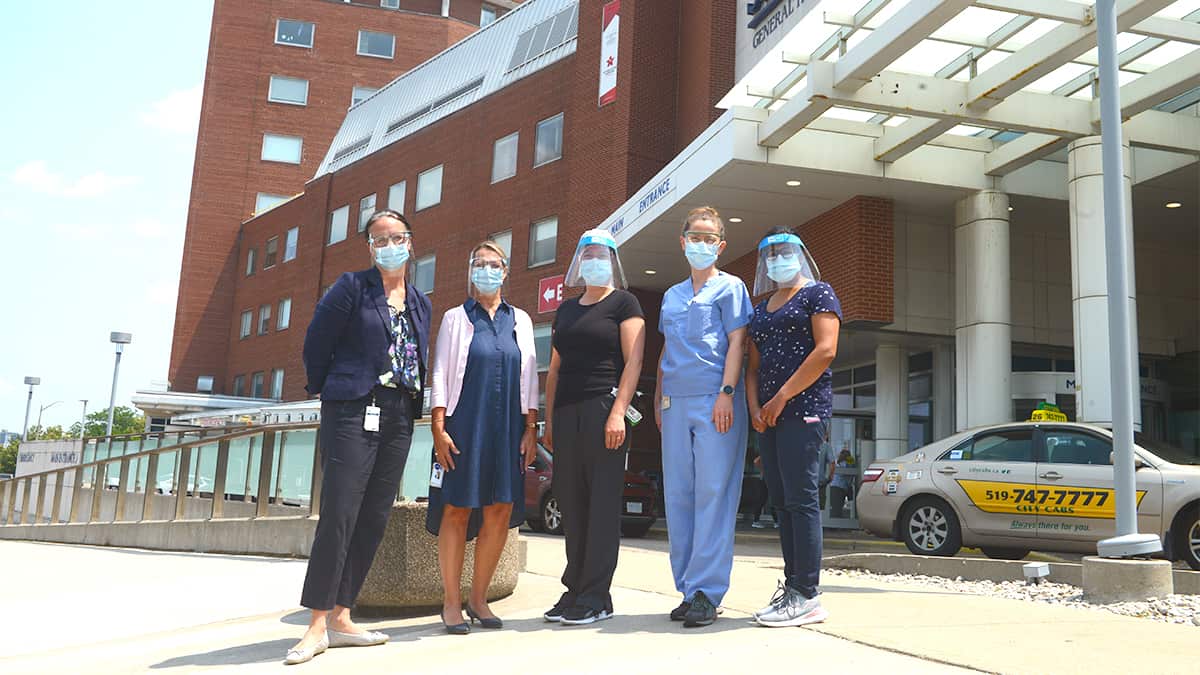The longstanding debate over the remediation of the Canagagigue Creek has no resolution in sight.
Everyone agrees there is ongoing contamination coming from the bank eroding on the west side of creek. But there’s no agreement about the Stroh Drain on the east side.
The Stroh Drain is a manmade ditch that was built sometime in the 1980s near the southeast corner of the Lanxess chemical plant property, and begins on the neighbouring property owned by Ron Stroh. It connects a lower-lying piece of land on the east side of the property nicknamed “The Gap,” and moves through the Stroh property, then across the Martin property before emptying into the Canagagigue Creek, which in turn flows into the Grand River.
The debate centers around whether or not The Gap and the Stroh Drain are currently significantly contributing to ongoing contamination of the Canagagigue Creek.
Much of the Lanxess property was formerly used by previous owners of the chemical factory as a dumping ground for toxic waste, including the east side. Wastes from the creation of herbicides used to make Agent Orange and other toxic chemicals were disposed there.
According to a 2021 report by one of Lanxess’ environmental consultants, five pits were built on the east side of the property beginning in the 1940s, along with other waste management areas. These pits remained more or less active until 1969-1970. Two of them were open until late 1990.
While these pits were active, company staff “relied heavily on evaporation and soil seepage to reduce liquid volumes. Intermittent overflow from the pits was directed into open ditches or furrows.”
According to the report, the drainage from the seepage of these pits was directed overland in open ditches that drained to former gravel pits at the south end of the property. However it can be noted the swampy area, or the Gap, is relatively close to the pits.
The Woolwich Technical Advisory Group (TAG) is a group of experts who keep tabs on the remediation process and offer advice to township council and others involved in the process. TAG member Sebastian Siebel-Achenbach has long been involved with the remediation efforts related to the chemical plant in Elmira.
Siebel-Achenbach argues that before the ponds were lined and capped, it is likely “effluent was deliberately allowed to overflow and channeled through a furrow southwards into a lower lying swampy area [The Gap].”
“Further proof that this became a man-made conduit was the construction of the “agricultural ditch” – what we call the ‘Stroh Drain.’ This was constructed sometime in the 1980s as it doesn’t exist in aerial maps prior,” he said.
“The location is the giveaway. It was laid within ten metres of the property line on the Stroh side right next to the Gap. I surmise that the swamp discharged into the drain which took the toxins downstream into the small Martin Creek, which then discharges into the Canagagigue.”
Sediment testing was done in the drain in 2020 by environmental consultants on behalf of Lanxess, which now owns and operates the chemical factory formerly operated by Uniroyal, Crompton and Chemtura. The drain was sampled at two points near the top and bottom. Four samples were taken, two between zero and ten centimetres in depth, and two between ten and 30 centimetres at each site.
Three of the four sediment samples came back with higher dioxin and furan levels than permitted by provincial guidelines. In one case, 28 times higher.
The Ministry of Environment Conservation and Parks also studied the area of the Stroh Drain in 2020. This study included two sites, one closer to where the drain enters the Canagagigue Creek, and one further up the drain. The sediment samples were taken with a shovel and between zero to five centimetres in depth.
The ministry’s study found that the amount of DDT was lower further up the drain. The report’s authors suggest that this is due to “an influence from the creek (e.g. from very high flow events that deposit sediments from the creek into the ditch).” The same was found for dioxin and furan levels in the ditch.
“The ditch itself does not appear to be a source of dioxins/furans to the creek as levels at DITCH 2 were lower than DITCH 1 and overall levels in the ditch were not much higher than those measured in the creek,” read the report.
In a TAG meeting earlier this month, Siebel-Achenbach argued the Stroh Drain should be further investigated. He said none of the testing of the drain so far has been thorough enough to determine if it is a significant pathway of contamination, continually leaking contaminants into the creek from The Gap. That’s because sampling only took place up to 30 centimetres in depth. Siebel-Achenbach is advocating for more meticulous testing.
To Siebel-Achenbach, thorough testing means “getting an independent company to do professional-grade sampling along the entire route, from when the pipe protrudes from the ground to when the liquid discharges into the Canagagigue Creek. We are not talking only about sediment sampling, but also of surrounding soils from surficial levels to depths that go down several metres to determine the potential extent of the contamination.
“Yes, this costs money, but to my way of thinking it is potentially well spent if we find contaminants of concern in that pathway. I’d rather know this now rather than after some of the creek has been remediated only to be re-contaminated because we didn’t factor in this pathway.
“Why not get a definitive answer?” he asked.
Not every TAG member concurs, however.
Referring to the study done by Lanxess, committee chair Tiffany Svensson said, “There are greater exceedances in other locations along the creek and one needs to consider the background concentrations as well. These are sediment results, which means they can/ likely do move with the water moving in the creek or drain. The fact that the lower concentrations are ‘upstream’ in the drain and that both the shallow and deep samples at this upstream location are about the same magnitude would suggest that there is not a significant source in the catchment area of the drain.”
Svensson’s line of thinking is if the Stroh Drain was a significant contributor of contamination, there would be higher amounts of contamination further up the drain, closer to The Gap, the possible source, but the highest levels of contamination are near where the Stroh Drain empties into the creek.
Svensson also argues that although the amounts of contamination in the Stroh Drain exceeded government standards by 28 times, there were other areas in the study area that were far higher. For example, one area studied just south of the Lanxess property showed contamination 182 times higher than regulation levels.
Michael Mackin, a spokesperson for Lanxess, says The Gap and the Stroh Drain have both been investigated and that Lanxess staff have evaluated the data extensively.
“We had confirmed the relative absence of impacts in these areas, providing the workplans and results with TAG and MECP (which concurred with the results). RAC (Remediation Advisory Committee) and TAG previously asked if we planned to further sample the area, however the data we received indicated no relevant impacts and therefore no reason to perform additional sampling,” he said.
Mackin said multiple samples, including from Lanxess and the ministry, indicate no further action is necessary in these areas.
“A couple of years ago, members of RAC, TAG and individual community members were invited to visit and tour the sites on two separate occasions. Around that time, the issue of ‘The Gap’ area was discussed at length with these stakeholders, and seemingly answered questions presented by TAG then,” Mackin said.
“While the MECP has previously stated publicly that there is no justifiable reason to complete any additional testing of the Stroh Drain and/or Gap area, Lanxess will of course work with the ministry and TAG should that change and testing be advised.”
The Ministry of Environment, Conservation and Parks is overseeing the remediation of the Canagagigue Creek, though has not issued a control order to the company about the creek. When asked if the ministry would consider requesting more thorough testing of the Stroh Drain, Gary Wheeler, a spokesperson responded, “The ministry is actively working with Lanxess, the Township of Woolwich and the local community to oversee the identification and remediation of potential contamination resulting from historic operations at the Lanxess site.
“At the ministry’s request, Lanxess is to include investigation results associated with the agricultural drainage ditch in their Canagagigue Creek human health and ecological risk assessment (HHERA), which is ongoing.
“We will continue consulting with all stakeholders on the Lanxess environmental investigations and remediation measures.”









